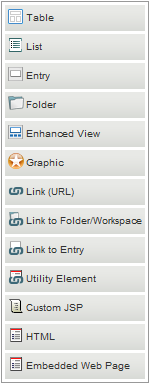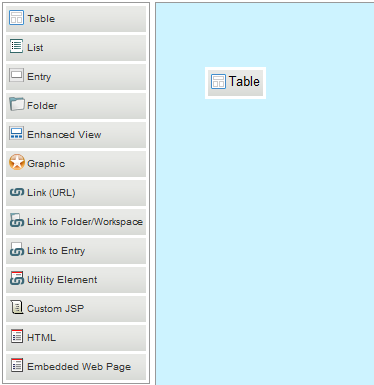6.4 Adding Content to Your Landing Page
To help make the landing page creation process easier and to help make your landing pages look more professional, review the best practices discussed in Section 6.1, Landing Page Best Practices.
-
Navigate to the landing page that you created in Section 6.2, Enabling the Landing Page View for a Workspace.
-
Click the Configure icon
 next to the folder or workspace title, then click Edit Workspace, depending on whether your landing page is on a folder or a workspace.
next to the folder or workspace title, then click Edit Workspace, depending on whether your landing page is on a folder or a workspace.

-
In the Landing Page Layout section, in the content editor, use the element palette to select the landing page element that you want to display on your landing page.

You can add the following elements:
-
Table: Creates a table with the number of columns that you specify. You can add other elements inside this table.
-
List: Creates a list where you can add other elements.
-
Entry: lets you reference an entry that has previously been created in Kablink Vibe.
The actual content of your landing page can be created in entries elsewhere on the Vibe site which are then simply referenced from the landing page. This is helpful if you want to duplicate the same information on multiple landing pages. After you create the information in an entry, you can then reference that entry from multiple landing pages.
When you add an entry to the landing page by using the Entry element, only the entry title and description can be displayed. If you want to display entry comments, add the Enhanced View element to the landing page.
-
Folder: lets you reference a folder that has previously been created in Vibe. You can choose how many entries from the folder that you want to display on your landing page at any one time.
-
Enhanced View: lets you display entries and folders in enhanced ways. The following options are available:
-
Display an entry: Displays the entry title, description, author, date, and the 10 most recent comments.
-
Display recent entries: Displays the most recent entries from the specified folder. Displays the title, description, author, date, and the 10 most recent comments for each entry.
-
Display a list of recent entries: Displays a list of the most recent entries from the specified folder. Displays the title, author, and date of the entry.
-
Display a sorted list of recent entries: Displays a list in alphabetical order of the most recent entries from the specified folder. Displays the title, author, and date of the entry.
-
Display a sorted list of files: Displays a list in alphabetical order of the files that were most recently added to the folder. This includes files that are attached to entries.
-
Display calendar: Displays the specified calendar with the full calendar view.
-
Display my calendar events: Displays all the calendar events and tasks that are assigned to the user who is viewing the landing page. Calendar events and tasks are displayed in a calendar view. Tasks are displayed on the calendar according to the task duration; tasks that do not have either a start and end date or a duration specified are not displayed.
-
Display task folder: Displays the specified task folder with information about each task, such as the title, due date, priority, and so forth.
-
Display my tasks: Displays all the tasks that are assigned to the user who is viewing the landing page.
-
Display survey: Displays the specified survey in a full, interactive view. Users can participate in the survey directly from the landing page.
-
-
Graphic: lets you reference a graphic that has previously been added to the workspace.
-
Link (URL): lets you create a link to a web URL.
-
Link to Folder/Workspace: lets you add a link to a Vibe folder or workspace.
-
Link to Entry: lets you add a link to a Vibe entry.
-
Utility Element: lets you add various utilities, such as the My Workspace link.
-
Custom JSP: lets you reference a custom JSP file that has previously been created by a Vibe administrator.
-
HTML: Displays an HTML editor where you can compose messages, create links, upload pictures, and more. The information that you create in this HTML editor is displayed on your landing page.
-
Embedded Web Page: lets you reference any website and display it on your landing page.
-
-
Drag the element that you want to display on your landing page and drop it onto the landing page canvas.

After you drop the element onto the landing page canvas, you are prompted to configure it.
How you configure a landing page element depends on the type of element that you add.
-
Configure the landing page element as described in Section 6.5, Configuring Landing Page Elements.